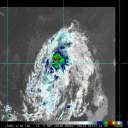Show Selection:
|
#900180 (Received by flhurricane at: 10:44 PM 27.Aug.2017)
TCDAT5
Potential Tropical Cyclone Ten Discussion Number 2
NWS National Hurricane Center Miami FL AL102017
1100 PM EDT Sun Aug 27 2017
Deep convection has been increasing in both intensity and coverage
during the past several hours in association with Potential
Tropical Cyclone Ten. However, satellite and radar data indicate
that the circulation remains poorly defined, therefore, the
system is not yet a tropical cyclone. The initial intensity is
held at 30 kt based on the surrounding surface observations and the
earlier ASCAT data.
The disturbance is located in weak steering currents, and has been
meandering during the last several hours. A continued slow and
erratic motion is likely to continue overnight and early Monday. A
mid- to upper-level trough currently over the central U.S. is
expected to approach the system, and should cause the disturbance
to begin moving northeastward by late Monday. A faster east-
northeastward to northeastward motion is forecast thereafter when
the system becomes embedded in the mid-latitude westerlies. The
models are in fair agreement, and only small changes were made to
the previous NHC track forecast. This forecast takes the center of
the disturbance near the Georgia and South Carolina coasts tonight
and Monday and along the North Carolina coastline Monday night and
Tuesday.
The elongated center of the disturbance is located to the west of
the main area of deep convection due to strong westerly vertical
wind shear. The shear is only expected to lessen a little during
the next 12 to 24 hours, but it will likely weaken enough to allow
the system to become a tropical cyclone. After that time,
increasing shear and interaction with the aforementioned trough
should cause the disturbance to lose its tropical characteristics in
about 48 hours. Strengthening is likely for a couple of days while
the system is post-tropical due to baroclinic effects.
Although the potential for tropical storm winds are within the
warning time period (36 hours), given the uncertainty in whether
these winds will occur on land in northeastern South Carolina and
southeastern North Carolina, a tropical storm watch remains in
effect for those areas. Note that north of Duck, North Carolina,
hazards from this system will be handled with non-tropical products
issued by local National Weather Service offices.
FORECAST POSITIONS AND MAX WINDS
INIT 28/0300Z 30.5N 80.8W 30 KT 35 MPH...POTENTIAL TROP CYCLONE
12H 28/1200Z 30.9N 81.0W 35 KT 40 MPH...TROPICAL CYCLONE
24H 29/0000Z 32.3N 79.9W 35 KT 40 MPH
36H 29/1200Z 34.4N 77.5W 35 KT 40 MPH...NEAR THE COAST
48H 30/0000Z 36.5N 73.8W 45 KT 50 MPH...POST-TROPICAL
72H 31/0000Z 39.9N 64.2W 55 KT 65 MPH...POST-TROP/EXTRATROP
96H 01/0000Z 43.2N 53.4W 60 KT 70 MPH...POST-TROP/EXTRATROP
120H 02/0000Z 47.2N 41.1W 45 KT 50 MPH...POST-TROP/EXTRATROP
$$
Forecaster Cangialosi |



